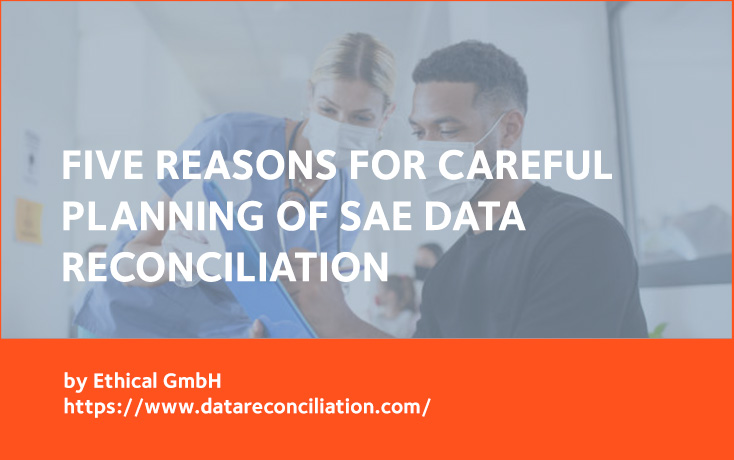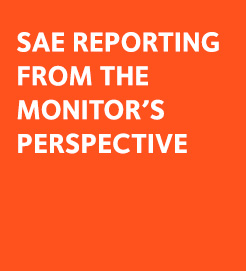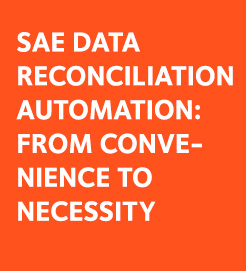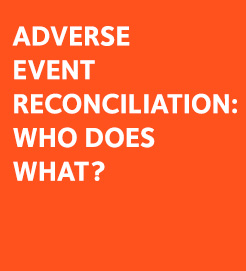In the current clinical development environment, Serious Adverse Events (SAEs) and other safety data are captured and recorded in parallel in two separate databases. Due to differences in the verification process used, a reconciliation is necessary to ensure full consistency of the data. Find out below the top five reasons why such reconciliation must be carefully planned and performed.
During all clinical trials, safety data are collected following two parallel processes and stored in two separate repositories: the clinical database and the safety database. These two sources must be reconciled before the database lock to ensure completeness and consistency of the safety monitoring of the trial. SAE data reconciliation is a crucial quality step that must be carefully planned very early in the clinical process, but why exactly is SAE data reconciliation so important?Reason 1: Considerable data is being collected during the study
The data are primarily focusing on Serious Adverse Events (SAE) but can also cover Adverse Events of Special Interest (AESI), Adverse Events (AE) leading to premature permanent study drug discontinuation and non-Serious Adverse Events linked to an SAE. Adverse Event verbatim, coded term, seriousness, severity, date of onset and resolution, hospitalization date and discharge date, treatment given for the event, action taken in regard to the study drug, outcome, potential sequelae and relation to the intake of study drug are only some of the data in scope.
Reason 2: The process and focus of data collection and verification differs between the two databases
While the clinical database is primarily concerned with completeness and consistency of all data for any given patient, the safety database is focusing on the facts around a particular event. Clinical data are extensively scrutinized using computer algorithms to ensure consistency and corrected via query issue and resolution while safety relies much more on narrative description in a medical language. Finally, clinical can take the time needed until data is clean but stops sharp at database lock while safety requires immediate reporting but can afford to follow up as long as needed until full resolution of an event.
Reason 3: Even from the same source, data present discrepancies when captured twice
Each time a piece of information is manually recorded, there is a percentage of error in the transcription. In past times when clinical data was transcribed by hand, the method of double data entry was routinely used to minimize this effect. The same applies between safety and clinical database data entry. Even the same information originating from the patient charts will present a percentage of discrepancies when transcribed in two different places.Reason 4: Regulators use the safety data for monitoring the safety of drugs
Pharmacovigilance is a highly collaborative operation that begins with the first administration of a new drug to a human being (known as: first-in-man) and continues way past the retirement of the medication from all markets, sometimes for more than one generation. In this process, the primary responsibility of the sponsor is to provide clean and reliable data in the shortest possible time to health authorities who, above and beyond delivering the marketing authorization, have the power to order the halt of studies, the modification of prescription directions or even the withdrawal of a drug from market. Of course, the sponsor has the responsibility to conduct their own safety monitoring, frequently assisted by external experts such as Data Monitoring Committees (DMC) or Data Safety Monitoring Boards (DSMB).
Reason 5: Patient safety matters above all
Beyond administrative, commercial or scientific reasons, the primary focus of all manufacturers of medicinal products is the patients. The purpose of their work is to treat and cure disease, alleviate suffering and burden and preserve the safety of patients. Clean and transparent safety data are the key to good pharmacovigilance and safety monitoring and contribute to the protection of patients during clinical trials and beyond.
Here’s 5 key elements to always keep in mind for successful SAE data reconciliation:
1. Don’t wait for the eleventh hour to begin. Safety data reconciliation can take time and resources. It must be conducted all along the study duration.
2. It’s not over until it’s over: discrepancies may emerge at the last moment if some previously reconciled data changes on either side.
3. Last minute queries may have to be answered as a result of reconciliation. Be prepared.
4. Humans are more intelligent than machines, but machines are much better with repetitive tasks. Use them.
5. The safety of patients is in your hands.
DOWNLOAD NOW THE FREE SAE RECONCILIATION HANDBOOK
The Manual / Reference Book with all the topics related to the Safety Data Reconciliation Management.







